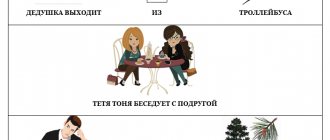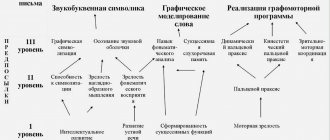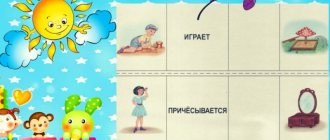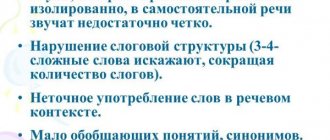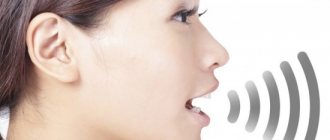Speech card for children with alalia; educational and methodological material on speech therapy on the topic
SPEECH CARD FOR CHILDREN WITH ALALIA
(General speech underdevelopment of levels I – II)
- Personal data:
- Last name, first name______________________________________________________________________________________________
- Date of Birth____________________________________________________________________________________
- Home address__________________________________________________________________________________
- Where did the child come from______________________________________________________________________________
- Start date of classes_______________________________________________________________________________
- Diagnosis of PMPK__________________________________________________________________________________________
- Conclusion No. ________________________ Duration of stay ___________________________________________
- Condition of hearing and vision ________________________________________________________________________________
- Speech activity: normal / below normal / no speech /_____________________________________________
- Understanding the speech of others: intact / reduced / significantly reduced /______________________________
- Was speech development interrupted?
II. Non-speech functions
- Attractiveness: attracted / requires additional stimulation / not attracted / _______________
- Contact: in contact / selectively in contact / does not come into contact / _____________________________
- Productivity: normal/below normal/low/extremely low__________________________________________
- Imitative activity
| Beginning of the year | The end of the year | |
| absence | ||
| action | ||
| word and action |
5. Perception
| Beginning of the year | The end of the year | ||
| Visual | "Find out the subject" in color, contour image; objects superimposed on each other, | ||
| Auditory | “Guess what it sounds like?” |
6. Understanding and distinguishing colors
| Beginning of the year | The end of the year | |||
| shows | calls | shows | calls | |
| Red | ||||
| Yellow | ||||
| Green | ||||
| Blue | ||||
7. Understanding different quantities
| Beginning of the year | The end of the year | |||
| shows | calls | shows | calls | |
| Big | ||||
| Small | ||||
8. Distinguishing and naming geometric shapes
| Beginning of the year | The end of the year | |||
| shows | calls | shows | calls | |
| Circle | ||||
| Square | ||||
| Triangle | ||||
9. State of memory and attention
| Beginning of the year | The end of the year | |||
| visual and visual | “Remember which toy is missing?” | |||
| "What changed?" | ||||
| auditory and auditory: | "Clap like me" | I | ||
| II | ||||
| III | ||||
| I - II | ||||
| I - III | ||||
| II - I | ||||
| II - II | ||||
| "Remember and Repeat" (syllable chains) | Mother | |||
| ma - mu | ||||
| ma - pa | ||||
| ma - pu | ||||
| ma - mu - mi | ||||
10. Constructive visual memory
| Beginning of the year | The end of the year | |||
| according to the model | by memory | according to the model | by memory | |
| triangle | ||||
| square | ||||
| bed | ||||
| high chair | ||||
- Thinking
| Beginning of the year | The end of the year | ||
| "Seguin Board" | |||
| Pyramid of 3-4 rings | |||
| “Make the Whole” (pictures, cubes) | 2 parts | ||
| (3-4) parts | |||
12. Nature of play activity: enters / does not enter into play / manipulates objects / plays nearby / play according to age / ________________________________________________________________________________________________
III. General and fine motor skills.
| Beginning of the year | The end of the year | ||
| Gross motor skills and spatial orientation | Show how the bunny jumps | ||
| Show how the bear walks | |||
| Put your hands up | |||
| Put your hands down | |||
| Hide your hands behind your back | |||
| Show me your right hand | |||
| Show your left hand | |||
| Jump up | |||
| Stand on one leg | |||
| Fine motor skills | "The birds are pecking the grain" | ||
| "Hare" | |||
| "Ring" | |||
| Clench and unclench your fist | |||
| Switching from one pose to another | "Fist - palm" | ||
IV. The structure of the articulatory apparatus, articulatory motor skills, speech breathing.
1. Anatomical structure of the articulatory apparatus:
- Lips (thick, thin, cleft, scars)___________________________________________________________
- Teeth (sparse, crooked, small, absent, outside the jaw arch) _________________________________________
- Jaws, bite (prognathia, progenia, open lateral, open anterior, cross)_______________
- Hard palate (high narrow, gothic, flat, cleft, subcumulous cleft)__________________________
- Soft palate (short, bifurcated, lack of a small tongue)__________________________________________
- Tongue (massive, small, with shortened hyoid ligament)__________________________________________
- State of respiratory and vocal function:
- Type of breathing: upper clavicular / diaphragmatic / abdominal / mixed / _____________________________
- Breathing volume: sufficient/insufficient/__________________________________________________________
- Direction of air flow during speech: through the mouth / through the nose / _________________________________
- Voice volume: excessively loud or soft/ muffled/ monotone/ nasal/ ___________
3. Nonverbal types of communication
| Beginning of the year | The end of the year | |
| use of facial expressions | ||
| gestures |
- completely replaces verbal communication
- actively uses
- as an aid to communication
- does not use
- State of articulatory motor skills:
| Beginning of the year | The end of the year | |
| Open your mouth wide | ||
| "Smile" | ||
| "Tubes" | ||
| "Spatula" | ||
| "Sting" | ||
| "Swing" | ||
| "Pendulum" |
Features: synkinesis, increased salivation, deviation of the tip of the tongue to the right/left, tremor, muscle hypertonicity / muscle hypotonicity, difficulties in finding an articulatory position, difficulties in maintaining an articulatory position, cyanosis of the tongue ___________________________________________________________________________________
V. Speech function
1. Study of the impressive side of speech.
1. Understanding speech at the dialogue level:
What is your name? _______________________________________________________________
Which toy did you like? _________________________________________________
Show me how you can play with a doll (car)? ____________________________________
2. Understanding the instructions:
| Beginning of the year | The end of the year | |
| Take the ball | ||
| Give me the doll | ||
| Throw the ball on the floor | ||
| Take the ball and give it to me |
3. Understanding words meaning:
| Beginning of the year | The end of the year | ||
| items | doll | ||
| car | |||
| uncle | |||
| aunt | |||
| cup | |||
| spoon | |||
| bread | |||
| cat | |||
| dog | |||
| boots | |||
| dress | |||
| jacket | |||
| a cap | |||
| actions | show who is drawing | ||
| is reading | |||
| costs | |||
| coming | |||
| is sitting | |||
| runs | |||
| lies | |||
| sleeping | |||
| eating | |||
| drinks | |||
| signs | big | ||
| small | |||
| hot | |||
| cold | |||
| sweet | |||
| sour | |||
4. Understanding phrases (based on pictures):
| Beginning of the year | Mid year | The end of the year | |
| The boy is walking | |||
| Kids are playing | |||
| Mom bathes baby |
5. Distinguishing between singular and plural meanings.
| Beginning of the year | The end of the year | ||
| Nouns | house - at home | ||
| table - tables | |||
| cup - cups | |||
| bird - birds | |||
| car - cars | |||
| Verbs | worth - worth | ||
| runs - run | |||
6. Understanding the meanings of nouns with diminutive suffixes:
| Beginning of the year | The end of the year | |
| house - house | ||
| chair - stool | ||
| ball - ball | ||
| cup - cup | ||
| ball - ball | ||
| doll - doll |
7. State of phonemic awareness:
| Beginning of the year | The end of the year | |
| Cat - whale | ||
| The house is smoke | ||
| Bear - mouse |
2. Examination of the expressive side of speech:
- General characteristics of speech
| Beginning of the year | The end of the year | |
| Absence | ||
| Babbling speech | ||
| The beginnings of a phrase |
:
- Learning active dictionary:
| Beginning of the year | The end of the year | |||
| onomatopoeia | The girl has a toothache. | a-a-a | ||
| How does a girl (Lala) cry? | wow | |||
| The girl got lost. | aw | |||
| How does a cat scream? | meow | |||
| How does a dog bark? | aw-aw | |||
| Amorphous and babbling words (presence) | ||||
| Nouns | Logical groups | Toys | ||
| Cloth | ||||
| Dishes | ||||
| Pets | ||||
| Body parts | hands | |||
| legs | ||||
| head | ||||
| eyes | ||||
| mouth | ||||
| nose | ||||
| ears | ||||
| Machine parts | wheels | |||
| headlights | ||||
| steering wheel | ||||
| doors | ||||
| Verbs | coming | |||
| eating | ||||
| sleeping | ||||
| lies | ||||
- Grammatical structure of speech:
1) plural of nouns:
| Beginning of the year | The end of the year | |
| cat - cats | ||
| eye - eyes | ||
| house - at home | ||
| car - cars |
2) diminutive form of nouns:
| Beginning of the year | The end of the year | |
| house - house | ||
| table - table | ||
| knife - knife | ||
| hand - pen | ||
| machine - machine |
3) Agreement of nouns with pronouns “MY, MY, MY”:
| Beginning of the year | The end of the year | |
| a cap | ||
| bed | ||
| cube | ||
| dress | ||
| chair | ||
| ball |
4) Use of verbs in the imperative mood (“Command”):
| Beginning of the year | The end of the year | |
| stop | ||
| go | ||
| lie down | ||
| sleep | ||
| eat | ||
| play |
- Syllabic structure of words:
| Beginning of the year | The end of the year | |
| Mother | ||
| dad | ||
| woman | ||
| tata | ||
| Kate | ||
| Vania | ||
| shadows | ||
| horses | ||
| children | ||
| Panama | ||
| cubes | ||
| poppy | ||
| juice | ||
| house | ||
| rooster | ||
| sofa | ||
| banana | ||
| is sitting | ||
| walks | ||
| cat | ||
| jar | ||
| bear |
5. Sound pronunciation
| VOWELS | CONSONANTS | |||||||||||||||||||
| A | U | ABOUT | AND | E | Y | P | B | M | N | IN | F | T | D | TO | G | X | WITH | Y | l | |
| N.g. | ||||||||||||||||||||
| K.g | ||||||||||||||||||||
Conclusion:
____________________________________________________________________________________________________________________________________________________________________________________________________________________________________________________________________________________________________________________________________________________________________________________________________________________________________________________________________________________________________________________________________________________________________________________________________________________________________________________________________________________________________________________________________________________________________________________
What is alalia
Alalia is usually called a group of speech disorders in which a child with normal hearing and intelligence does not develop speech, or it appears very late.
With alalia, speech may be completely absent - the child is simply silent, or almost completely - that is, he utters individual inarticulate words that are incomprehensible to others.
Let us briefly look at how speech is formed during normal development.
— The first words appear about a year ago. By the age of two, children should be able to communicate in short, simple sentences. These sentences, of course, are still very imperfect - there may be omissions of words that the child does not yet know. Many words are pronounced distorted and sound very funny. At this age, children master the sound composition of words and learn to formulate their statements grammatically correctly. They understand the speech of others well when it concerns familiar subjects and topics. — At three years old, a child should speak quite competently, in full sentences, almost like an adult. The only difference is that his speech will express his still limited life experience. Incorrect pronunciation of individual sounds at this age is natural and is not considered a deviation from the norm.
Speech development with alalia - Speech may not arise at all (the child remains mute) or develop extremely slowly. So by the age of ten (or even twelve) the child will speak almost like a two-year-old or three-year-old, very unintelligibly - an incomplete, grammatically unformed phrase with numerous violations of the pronunciation of sounds. - Speech can begin to develop, more or less actively, after five or six years. But by the time the child enters school, he will still not reach normal levels, so education in a regular school will be inaccessible to him.
In any case, children with alalia will experience a lag in intellectual development due to speech impairment. You can talk about the presence of alalia in a child starting from the age of three. Until this time, it is generally accepted that he has delayed speech development.
Delayed speech development is usually overcome by the child on his own (most often leaving behind traces in the form of defective pronunciation of sounds and a predisposition to impaired written speech).
There are cases (almost only in some boys, most often hereditarily determined) when a previously silent child, at about three years old, suddenly begins to speak in a completely full, expanded phrase, pronouncing all or almost all sounds.
It is difficult to distinguish a delay in speech development from alalia (there is only one reliable criterion here - the time during which the delay itself is overcome, but alalia is not). Therefore, a non-speaking child should be consulted by a speech therapist at the age of two. If possible, classes should begin as early as possible.
If a child has a delay in speech development , speech therapy classes will boost his speech development and help prevent complications that are inevitable with this defect. For a child with alalia, timely speech therapy sessions are the only opportunity to gain full speech. The duration of the course of correction depends on the form and severity of the disorder, but even with the most “favorable” course of alalia it can hardly be less than six months.
There are three types of alalia, and by checking their child’s speech, parents can presumably determine which form of alalia he will have to “fight” with.
Sensory alalia
A child cannot learn to speak because he does not distinguish between the sounds of speech; it is as if he “does not hear” them. At the same time, he hears any other “non-speech” sounds very well and reacts to them.
Such a child usually lacks his own speech completely, or there may be individual babbling words, or there may be echolalia (when he repeats a word he has just heard, if he is able to remember it for a short period).
Since the child does not perceive the sounds of speech, he does not understand the speech of others.
Sensory alalia can be expressed to varying degrees.
- The child may not perceive speech sounds completely - not pay attention to them. Then he does not react at all to speech and gives the impression of being deaf and mute.
- The child may have no reaction to the human voice at all. He does not hear or distinguish people's voices.
— A child can perceive some speech sounds and their combinations, but it is very difficult to distinguish between them. Then he responds to verbal appeals, but still does not understand their meaning or understands it very distantly.
Basically, he orients himself based on the situation, reacting to the gestures of the people around him, facial expressions, turns of the head, and roughly guesses what is being said and what is happening. In this case, parents may consider that the child has a completely satisfactory understanding of speech.
To tentatively determine whether a child has sensory alalia, parents need to check whether the child understands simple instructions and the meaning of words. Invite him to perform well-known actions (approach something, bring something, etc.). Ask to show this or that thing (window, table), to make this or that movement (sit down, lie down, walk). All instructions must be in exclusively verbal form, completely avoid any kind of gestures: pointing gestures, turning the head, looking at the object. Also check how your child reacts to speech sounds and human voices. Call him behind his back (hey, ow), pronounce vowels and consonants and see if they attract his attention. A child who cannot understand speech must have his physical hearing tested. Motor alalia
A child cannot learn to speak due to poor control of his speech organs (tongue, lips, lower jaw).
At the same time, his muscles are absolutely healthy, he simply cannot act with them at his own discretion (voluntarily). Moreover, he fails, or only poorly succeeds in speech movements (he cannot pronounce speech sounds, and therefore words), but non-speech movements are in perfect order (he opens his mouth while eating, chews, licks, smiles, etc. .).
Speech understanding is intact in this form of alalia.
Motor alalia can be expressed to varying degrees.
- The child may be unable to make any voluntary movements with the organs of speech, even just to open his mouth upon instructions. However, the same involuntary actions are not affected (that is, he opens and closes his mouth perfectly while eating). With such severity of the disorder, the child, as a rule, does not speak at all or makes inarticulate sounds.
- The child is able to make simple voluntary movements with the speech organs (copy them). In this case, he may develop some speech. He can very imperfectly pronounce a limited number of words consisting of individual syllables and sound combinations. The same word can be pronounced differently each time, since he does not remember the speech movements that comprise it.
To roughly understand whether a child has motor alalia, parents need to determine how well he controls his speech organs. Check if he can imitate (follow you in your demonstration) certain movements with the speech organs: open and close his mouth, stick his tongue out of his mouth and put it back, smile and stretch his lips into a tube, raise his tongue up to his teeth and lower it down. The movements must be performed while looking in the mirror. If the child cannot cope with these actions, check whether he is generally able to perform at least some movements with his speech organs according to the instructions. For example: ask him to open his mouth, show this action several times, tell him to imagine how he eats, bring a spoon to his mouth. Or: smile, pretend to laugh, invite your child to laugh together.
Sensorimotor alalia
It is a combination of the auditory and motor disorders described above, expressed to varying degrees, and therefore is the most severe speech defect.
Polyakova Marina Anatolevna
Do you need a children's speech therapist? Sign up for a consultation by phone or through the feedback form in the “Contacts” section.
Speech therapy card for diagnosing dysarthria
Larisa Ermakova
Speech therapy card for diagnosing dysarthria
Speech therapy card for the diagnosis of dysarthria
Full Name ___
Age ___
Pronunciation side of speech
1. Degree of speech intelligibility: (speech is slurred, difficult to understand for others • speech intelligibility is somewhat reduced, speech is blurred • speech intelligibility is not impaired) ___
2. Rate of speech (normal, tachylalia, bradyllalia, hesitation, stuttering)
___
3. Rhythm of speech (normal, drawn out, chanted, depends on the manifestation: hyperkinesis)___
Breathing (free, labored, shallow, shallow, uneven)
• Physiological breath (deep, insufficient, short, intermittent)
• physiological exhalation
(long, shortened, presence of hyperkinesis: rigidity)
• Differentiation of nasal and oral exhalation • Presence of lower diaphragmatic breathing • Speech exhalation
(short, intermittent, sufficient, presence of hyperkinesis, rigidity)
___
___
Voice
• N (strong, voiced)
• Insufficient voice strength, weak, quiet, depleting as one speaks • Deviations in voice timbre (dull, constricted, hoarse, tense, intermittent, trembling, hyponasalized, hypernasalized, nasal emission)_ • Weak expression or absence of voice modulations (lowly modulated
or unmodulated voice , monotonous)
___
Synchronicity of breathing, voice production and articulation (N, violation)
___
Structure and mobility of articulation organs
Neurological syndrome due to disorder of the muscles of the speech apparatus (spastic steam, rigidity, hyperkinesis, ataxia, apraxia)
___
Facial muscles
• Hypomimia • Impaired muscle tone (hypertonicity, hypotonicity, dystonia, N)
• Smoothness of nasolabial folds • Oral synkinesis • Tremor of the chin • Asymmetries • Hyperkinesis • Rigidity ___
Lips (thick, thin, M)
___• Tone
(hypertonicity, hypotonicity, dystonia, N)
___• Mobility
(sedentary, mobile)
___• Presence of clefts or postoperative scars___
Teeth
• Large, small, rare, frequent, presence of extra teeth, dentition, dentures, N ___
• Bite (anterior open, lateral open, prognathia, progenia, correct)
___
Hard palate (gothic, low, presence of cleft or postoperative scars, N)
___
Soft palate (mobile, fixed, long, short, cleft or postoperative scars, submycotic cleft, uvula)___
Tongue (thick, small, wide, narrow, forked, shortened hyoid ligament)___• Muscle tone (spasticity, hypotonia, dystonia, N)
___• Hyperkinesis, tremor___• Deviation
(deviation)
of the tongue to the right/left___• Blue tip of the tongue___
Volume of articulatory movements of the tongue (strictly limited, incomplete, complete)
___• The tongue does not move out of the mouth___• Upper elevation___• Lateral abductions
(turns to the right/left)
___
• Clicking ___• Licking lips___• Ability to maintain articulatory posture___• Ability to switch___
Hypersalivation___
Chewing (does not chew solid food, difficulty, N)
___
Swallowing (choking, not impaired)
___
Impaired sound pronunciation (Not impaired. In isolation, all sounds are pronounced correctly, but with increasing speech load, general blurred speech is observed)___
Conclusion___
Recommendations ___
Logo correction diary : ___
